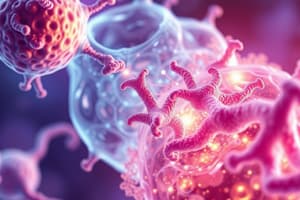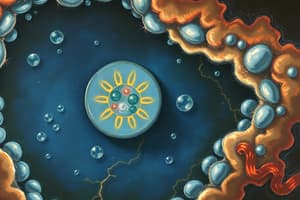Podcast
Questions and Answers
What is the function of lysosomes in the cell?
What is the function of lysosomes in the cell?
- To maintain the cell's shape
- To package and transport proteins and lipids
- To break down molecules for recycling (correct)
- To modify, sort, and package proteins for secretion or use within the cell
What is the role of the cytoskeleton in the cell?
What is the role of the cytoskeleton in the cell?
- To make and break down molecules
- To control what enters and leaves the cell
- To detect stimuli
- To maintain the cell's shape (correct)
Which organelle is responsible for making ATP?
Which organelle is responsible for making ATP?
- Ribosomes
- Golgi apparatus
- Endoplasmic reticulum
- Mitochondria (correct)
What is the function of the cell membrane?
What is the function of the cell membrane?
What is the role of the nucleus in the cell?
What is the role of the nucleus in the cell?
What are the different protein functions in the cell?
What are the different protein functions in the cell?
What is alternative splicing?
What is alternative splicing?
What is the function of lysosomes?
What is the function of lysosomes?
What is the role of the Golgi apparatus?
What is the role of the Golgi apparatus?
What is the function of the cytoskeleton?
What is the function of the cytoskeleton?
What is the site of protein synthesis in a cell?
What is the site of protein synthesis in a cell?
What is the function of ATP in a cell?
What is the function of ATP in a cell?
What is the function of the endoplasmic reticulum in a cell?
What is the function of the endoplasmic reticulum in a cell?
What is alternative splicing?
What is alternative splicing?
Flashcards are hidden until you start studying
Study Notes
Cell Biology and Organisation
- Cells have different jobs such as detecting, signalling, digesting, absorbing, fighting infection, and moving.
- Cells perform processes such as making and breaking down molecules, changing membrane voltage, secreting and transporting molecules, and detecting stimuli.
- The cell membrane controls what enters and leaves the cell and contains various proteins and molecules that facilitate different processes.
- The cytoplasm is the material inside the cell membrane and contains water, ions, small molecules, amino acids, and soluble proteins.
- The cytoskeleton helps maintain the cell's shape and consists of filaments and tubules.
- The nucleus contains most of the cell's DNA and controls the cell's activities.
- Ribosomes are the site of protein synthesis, while the endoplasmic reticulum packages and transports proteins and lipids, and the Golgi apparatus modifies, sorts, and packages proteins for secretion or use within the cell.
- Lysosomes use enzymes to break down molecules for recycling, while mitochondria use energy stored in glucose to make ATP.
- Protein functions include antibodies, enzymes, hormonal and structural proteins, storage and transport proteins, and contractile proteins.
- Alternative splicing allows for different proteins to be made from a single gene by chopping out introns and sticking exons together.
- Protein structures include primary, secondary, tertiary, and quaternary structures.
- ATP drives various cellular processes, such as protein synthesis, muscle contraction, molecule transport, and heat production.
Cell Biology and Organisation
- Cells have different jobs such as detecting, signalling, digesting, absorbing, fighting infection, and moving.
- Cells perform processes such as making and breaking down molecules, changing membrane voltage, secreting and transporting molecules, and detecting stimuli.
- The cell membrane controls what enters and leaves the cell and contains various proteins and molecules that facilitate different processes.
- The cytoplasm is the material inside the cell membrane and contains water, ions, small molecules, amino acids, and soluble proteins.
- The cytoskeleton helps maintain the cell's shape and consists of filaments and tubules.
- The nucleus contains most of the cell's DNA and controls the cell's activities.
- Ribosomes are the site of protein synthesis, while the endoplasmic reticulum packages and transports proteins and lipids, and the Golgi apparatus modifies, sorts, and packages proteins for secretion or use within the cell.
- Lysosomes use enzymes to break down molecules for recycling, while mitochondria use energy stored in glucose to make ATP.
- Protein functions include antibodies, enzymes, hormonal and structural proteins, storage and transport proteins, and contractile proteins.
- Alternative splicing allows for different proteins to be made from a single gene by chopping out introns and sticking exons together.
- Protein structures include primary, secondary, tertiary, and quaternary structures.
- ATP drives various cellular processes, such as protein synthesis, muscle contraction, molecule transport, and heat production.
Studying That Suits You
Use AI to generate personalized quizzes and flashcards to suit your learning preferences.




